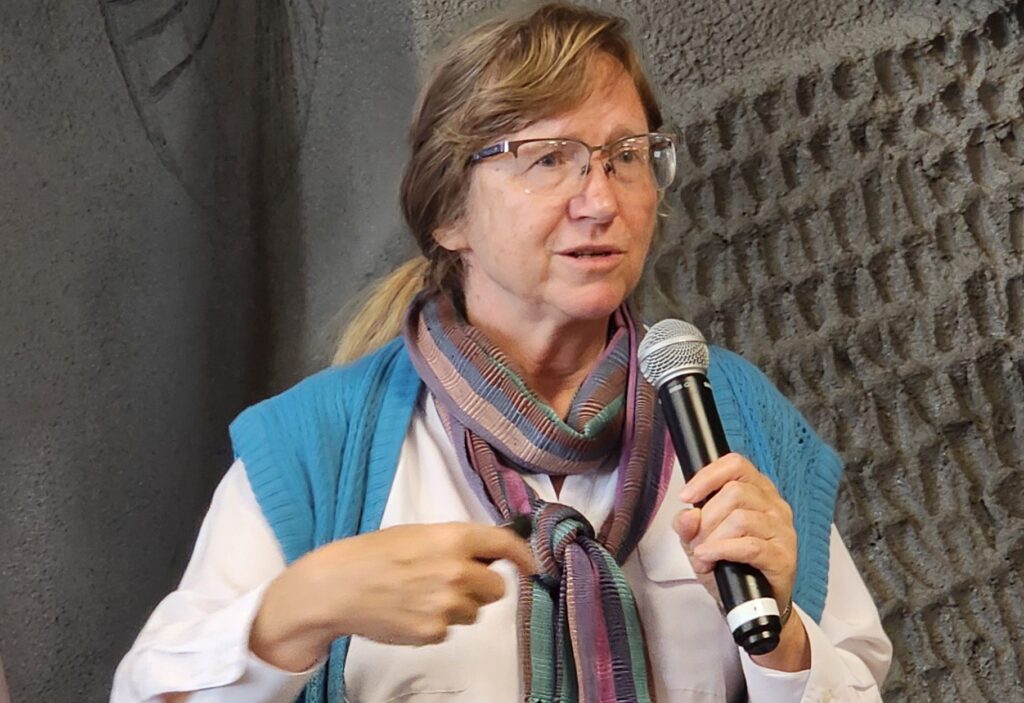By JAN McLAUGHLIN
BG Independent News
Lucy Long is peeling back the history of apples to get to the core of their meaning to people of the Midwest.
While most people eat with little thought beyond each bite, Long relishes the meanings behind regional dishes. And people pay attention to her observations. She has been interviewed on NPR about the status of green bean casseroles on dining room tables in the Midwest.
Now it’s apples that are appealing to Long’s appetite for learning. She recently shared her research with members of the Bowling Green Kiwanis Club.
Long, of Bowling Green, directs the independent nonprofit Center for Food and Culture and is retired from teaching classes at BGSU in folklore, popular culture, American studies, ethnic studies, nutrition and tourism.
Her research focuses on connections between food and culture. She is currently completing manuscripts for two books: “Interpretation with Food” and “Apples in the Midwestern Imagination.”
Long, who grew up in the mountains of North Carolina, remembered experiencing “culture shock” when first moving to Ohio.
“Where we grow up influences what we eat,” she said, recalling that most midwesterners don’t think this region has its own culture. Long disagrees – but the culture here isn’t what people from other regions believe it to be.
And now that she has lived in the Midwest long enough to understand the culture, Long said “my hackles rise” when others refer to this region’s stereotype of being bland and boring. Sure, meat and potatoes, and other foods heavy in carbs and fats, are staples here. But there is more to midwestern diets.
Apples play a big part, whether they are Granny Smith, Pink Lady, Golden Delicious, Honeycrisp or Jazz varieties. In midwestern kitchens they are cooked into applesauce, baked into apple dumplings and apple crisp, dipped into candy apples, and deep fried into apple doughnuts.
“I have to do research, so I have to eat all these things,” Long said with a grin.

Apples have a place in the memories of midwesterners, whether it’s recollections of going to an orchard to pick them, bobbing in water for them at childhood parties, or shining apples to give to their favorite teachers.
We’ve been cautioned to not tip the apple cart, that one rotten apple spoils the whole barrel, and that an apple a day keeps the doctor away.
Apples have come to represent Midwest values and memories.
“These memories tie us with our places and our people,” Long said.
Despite apples having prominent roles in American lunch boxes, healthy snacks and desserts, the fruit isn’t native to these shores. A botanist traced apple DNA to Kazakhstan, where local residents there pointed the scientists to a forest full of wild apple trees.
“From there, they spread throughout the world,” Long said.
There are an estimated 7,500 varieties of apples in the world, and 2,500 in the U.S. Only the crabapple is native to North America, she said. Apples are big business in the U.S., with 100 varieties grown here commercially – the Delicious apple variety being the most common.
Long polished up on apple history, noting the pilgrims planted the first U.S. apple trees in the Massachusetts Bay Colony. In 1730, the first apple nursery was opened in Flushing, New York. America’s longest-lived apple tree was reportedly planted in 1647 by Peter Stuyvesant in his Manhattan orchard and was still bearing fruit when a derailed train struck it in 1866.
The early apples in the U.S.were bitter, tart and hard – with all being used to make cider, Long said. It took generations of grafting to make the large sweet apples produced now.
As the Northwest Territory was being settled in the late 1700s, settlers purchasing acreage were required to plant apple or plum trees on their properties, Long said. That was good news for Johnny Chapman, better known now as Johnny Appleseed.
While Chapman was an early environmentalist, he was also a fruit tree salesman who helped plant orchards in the Midwest, primarily in Ohio, Indiana and Pennsylvania. He grew trees from seed – with no grafting used – and sold them for 3 to 5 cents a piece.
The Walt Disney animated version of Johnny Appleseed gave the character the ability to talk with animals. But some of his other unusual qualities have been reported as factual, with him often walking barefoot for many miles, and sometimes wearing his saucepan on his head.





